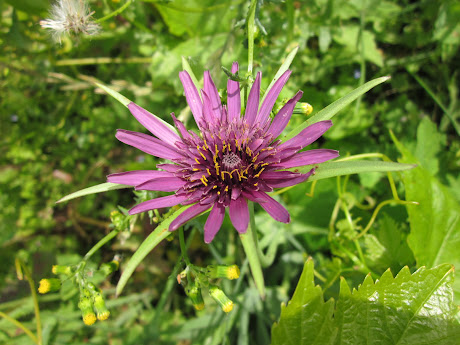Wildflower Wednesday: Fox and Cubs
I guess it was only a matter of time before this plant arrived in my garden, as I've admired quite a few broad swathes of it on the grassed areas on our estate here in Chippenham. I now have a dilemma; whether to leave or not as it's invasive. The site linked to above has dire warnings about it, despite its attractive appearance:
"This attractive member of the daisy family makes a wonderful display in summer when it appears on roadside verges and banks, but do not be tempted to encourage this plant to grow in the garden: it is a tenacious weed that spreads and is very difficult to eradicate once it has got a hold."
The site goes on to say its ability to spread by seed, runners and rhizomes is why this plant is so successful and tenacious in its conquest of our land. It hails originally from the alpine regions of central and southern Europe and is another of our garden escapees after its introduction in the seventeenth century. The RHS adds it "... is visited by bees for nectar and pollen." That last comment adds to my dilemma.
I have a laissez faire track record as far as the front lawn is concerned. As you can see it's mainly creeping cinquefoil (Potentilla reptans), which is actively spread by runners. The RHS website also warns this one's invasive; I've found it's fairly easy to keep within the bounds of the lawn by weeding out the shallow rooted runners as and when needed. It certainly saves on lawn mowing and keeps a greener colour than grass during the summer months.
Whether the fox and cubs remains with it is yet to be seen...
* = I wrote about another orange wildflower find last year, Jewelweed.
** = it took me several attempts to get that latin name right while I wrote this blog post 😉
It's great to have another opportunity to join Gail's Wildflower Wednesday, having made so many new floral discoveries locally this year whilst under Lockdown. I missed seeing Gail and my other Fling pals from across the pond a few months ago due to our Covid-19 shenanigans, and the opportunity to join her with this post makes me feel much closer to her and the others somehow.












Orange is one of my favorite colors and I love the common name! It's a tricky decision with invasive plants. In my garden, I have opted to eliminate invasive plants to save myself lots of work trying to eradicate later on. It's hard when the flower is attractive and pollinators like it too. Good luck with this one!
ReplyDeleteI'm still pondering Karin!
DeleteThat is a gorgeous color. I agree with Karin, especially regarding super aggressive invasives. Thanks for joining. I was looking forward to visiting with you, too. xoxo
ReplyDeleteMiss you Gail x
DeleteIt looks like an orange cousin to hawkweed. I'm sure the bees love it. I leave my dandelions in peace for the bees.
ReplyDeleteSpot on Diana! It is indeed one of the hawkweeds :) I do the same with my dandelions, then carefully harvest all their clocks before the seeds disperse.
DeleteIt looks quite cheerful and sunny, but I’d be nervous about that invasive designation! I’m forever trying to remove ground covers that I foolishly let go crazy here.
ReplyDeleteSame here Robin, I suspect it'll go. I've been lucky with the other invasives here as they've been relatively easy to keep under control.
DeleteHello Michelle, I keep meaning to come back with a comment here but I'm hit and miss with phone and tablets just now and time is flying by. I can understand your dilemma here. It was roadside along motorways, that my eye was drawn to the vibrant rust orange of foxes and cubs. I loved its colour. It was a few years before I worked out an ID and I (dare I say this) introduced it to my garden along with other wild flowers. I do that from time to time.
ReplyDeleteThe question now lies, did I regret it? No. Is it invasive? Yes. How much of a problem has it been? Annoying rather than a nightmare. What do I do when it chokes round other plants? I lift the whole plant up and tug it away. The leaves are robust and the roots not that deep rooted, more string like. Does it still remain? Yes, I let odd bits flower before removing them as that colour is so worth it. Is there any place it is a nightmare? Yes, the grass edges - beware there, Michelle. Please post back on how you get on ����
Excellent information, thanks Shirley. They've established themselves on the edge of our lawn, so I guess that means it's curtains for them ;)
Delete